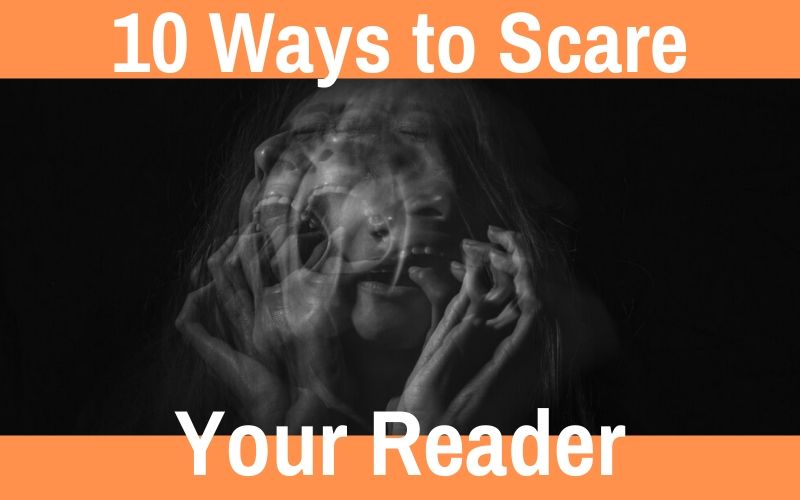Latest Writing Video! |
|
It is the eve of Halloween and my thoughts turn to that of terror. The night used to be filled with horrors that kept me awake and my heart pounding. Now, as I’ve grown older, what stresses me isn’t fictional monsters, but the same stresses every adult has. In that sense, it’s difficult to write a thriller to scare my readers. Or is it? 1. Evoking Fear by Popping the Bubble“Where there is no imagination there is no horror.” - Sir Arthur Conan Doyle A writer must look to their creative-side in every case, not just horror. A wonderful fiction or a terrifying thriller is all the product of a writer’s imagination. To make better use of this tool at your disposal, you need to place yourself in the shoes of your protagonist/victim. Make them happy, secure in their own right. Have your character believing they are safe, make the reader believe they are safe. Once you have accomplished this, leave the front door open at night. Have them spy a shadow in the empty distance. Have your character’s muscles tense up as they realize that it is too quiet for everything to be okay. Make sure your character knows they are not safe anymore. 2. Unknown and Unexpected“We do not fear the unknown. We fear what we think we know about the unknown.” - Teal Swan You are not the only one with a brilliant imagination. The reader has their own dreams and their own nightmares. That is something you can use to your advantage. The insecurity of the reader, the anxiety fuelled terror that they bring on themselves when confronted with the unknown. To take full advantage of this, you give no hint of what goes bump in the night. You just make sure your reader feels that is evil and it is watching. A malevolent creature or an evil person, who does not panic or jump out at the character. Instead, they wait and they strike when the character least expects it. 3. A Dark, Intelligent Entity“All writing is a form of manipulation, of course, but you realize that a plain sentence can actually do so much.” - Colm Taibin While we can easily create a character that is harmless, one that is good and unsuspecting, can we create the same character and make them evil? Creating a villain is by no means easy in this genre, but it is essential. Creating a villain in a character that nobody suspects is an art form that you should explore. Yet, in addition to that, you need to give your antagonist intelligence. A mindless monster soon loses it’s scare-factor when the reader and character realises it is lacking in the brain department. Give them that Hannibal charm and intelligence. Make them truly a threat in every way. If your protagonist bests them, then you have a more satisfying ending. 4. Short, Powerful SentencesLong sentences evoke a sense of calm, of security. These sentences are slower to read and therefore give the reader time to breathe, to relax. It is for this reason you must adopt a change in your writing in certain scenes of your novel with with more frequent periods. You must alert your reader. Throw them into deathly silence. Let them know something is in their with them. Make them strain their ears. Make their body tense. Make them helpless. All they could hear was the pounding of their hearts. The rush of their blood. Deaf to what comes next. That should provoke suitable tension to get the reader holding their breath and dying to hear what happens next. 5. Pacing can PetrifyThere is a pause that follows tension. A brief moment where something scary is expected. Something in the dark to be revealed. That is the worst time for your antagonist to make an appearance. expects it, the character expects it. The answer to the terrifying question. To pace an effective horror/thriller/suspense filled story, you need to decide what kind of story you want to tell. Would your antagonist reveal themselves in this moment or continue the torment? The best time to reveal your antagonist for what they are is at least in the second-half of your story or better yet, in the last quarter. Keep your reader guessing, keep them on the edge of the knife. Pace your horror with moments of safety in-between, then when the protagonist is close to figuring it out how to stop the antagonist, you keep horror coming. All leading up to the ultimate climax. 6. Setting a Creepy Scene“The last safe place is safe no more.” - Daniel Handler There are many places you can take your reader. Some of simple, such as a grocery store. Yet, if you strip away what makes these places simple, what makes them safe, it can make for a terrifying setting. You don’t need to make it night, you just need to make it dangerous. Something is there or not there. A friend of the protagonist promised to meet them at the bookstore, but they aren’t there. The building is empty, the doors are locked. Even with their backs to the wall, they are still afraid of what’s behind them. It keeps the protagonist spinning on the spot and the reader right there with them. Anywhere can be the perfect setting if you make it so. 7. Buckets of Blood?You don’t need buckets of blood to make a scene scary. Gore is only another tool to be used sparingly. Unless your antagonist is a walking puddle of red, painting the room with the stuff soon loses its scare-factor. That is not to say that you should avoid using some gore, a few splashes of the tomato sauce, but there has to be more to it than that. Whose blood is it? How did it get there? If you don’t have something or someone raising those questions, then blood is just blood. 8. What Scares You?You no doubt heard the line that should write about what scares you. What your particular phobia is can make for a great book, that is true, but that doesn’t limit you from writing about something else. If that were the case, then Stephen King would be scared of anything and everything. The fact of the matter is, you can write anything you wish to write. You can write a crime thriller of a detective chasing a brutal killer. You can write a novel on zombies, vampires or ghosts. Anything that you wish to write will be great, because that is what you chose. It is what you prefer to write. Don’t shoot for the obvious if the obvious doesn’t interest you as a writer. 9. The Twist...of the KnifeOften in these genres a twist comes into play. Be it the killer is the protagonist, there is no real monster, there is a real monster or perhaps none of it ever happened...yet. These twists are often essential if you want to keep the reader twisting in their seat. Suppose your story seems fairly predictable around halfway through. You then want to change that, otherwise it isn’t as scary anymore. You can’t break the theme of the novel and change what you planned, but you can make it more interesting. Suppose the killer does something different. The protagonist kills the wrong one. The slow, tense crawl becomes a life-threatening chase. The world is not what it seems and neither is the protagonist. If done right, you pull the rug from underneath the readers feet and have them scrambling for answers and once more feeling insecure. 10. ClichesAh, cliches. The common serial killer or the typical werewolf or the spooky ghost girl we all know and love. Cliches are under debate. Some writers believe cliches should be avoided. That cliches ruin a novel, take away from the quality and make a story predictable. Yet, I happily disagree. Cliches are cliches for a reason. People love to write them and people love to read them. Yes, you can take it too far and make your story predictable, but you can also take the cliche and make it scary again. Zombies have been done to death, but people still find news of bringing the genre to live. Forgive the puns. The same goes for any other stereotypes. You haven’t had your say on the cliches. You can write a terrifying novel on Dracula, creepy, ghost girl or any other cliche out there! ConclusionI hope you enjoyed this article on horror writing and find the tips useful! There are many factors to consider when writing any novel, some changes in style that need to be made. Some of these tips suggest some writing changes, such as short sentences, but you can still retain your own writing style throughout. With that, thank you for reading and as always… Good day, goodnight and happy writing! Thank You!Dear Writer, Thank you for finishing this article. I had a lot of fun writing it and I hope you truly enjoyed it. There are many things you will learn from the writing experience and the 150 above are only a few. As a big thank you I would like to offer you something for FREE! A writing course on how to improve your main character! Click here to check it out your course. In addition, if would like to receive more content, bonuses and some big discounts on future courses, join the writers group here. Thank you very much for reading! Kind regards Matthew Dewey, Writer Pin for Later
0 Comments
Leave a Reply. |







